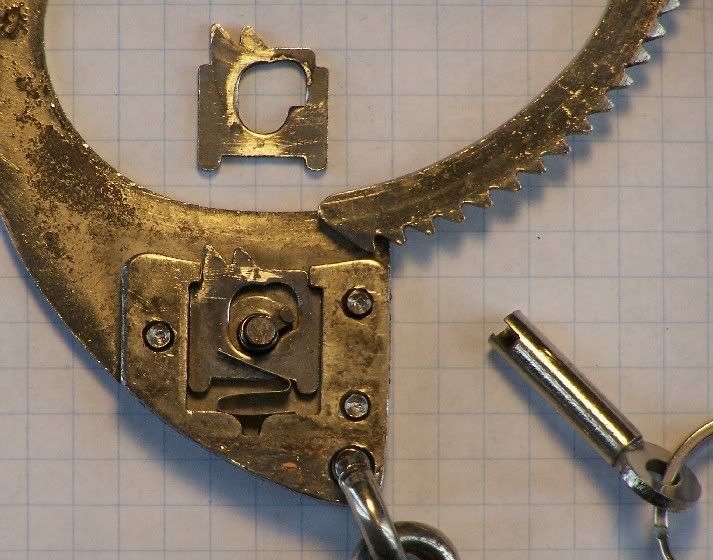The Hiatt model 1960 arrived late last week, just in time to be added to a demonstration I was running.
Here is a full view of cuffs:

A few things stand out about these. First is the shape of the bodies of the handcuffs, they are very asymmetrical and the pivot for the ratchet arm is much more 'off center' than a contemporary US design. Then there is the chain and swivel design, the links on the body are semi fixed and full rotation is achieved by a single swivel in the center of the chain, this is a legacy of 19th century designs. The final outward point of interest is the key and keyway, the key has no flag, gust a simple notch cut into the tip, the keyway is similarly round, this is due to the unusual design of the lockwork which we will look at later.
Before we move on to the inner workings, the keen eyed will have noticed that some of the scratches in the finish are actually light hand engravings. The Hiatt 1960 was not only Hiatt's first 'modern' swing-through design (despite having produced a copy of one of Peerless' Adams' patent designs under license before World War 2), this model was also the first modern handcuff design adopted by any of the UK police services. While it did have some drawbacks and proved less than popular with the constabulary it was sufficient to convince the Home Office to move away from the traditional Darby and Tower type handcuffs that the Police forces of the UK had been using for the previous several centuries. Since these were police issue (these were in fact discovered a few weeks ago by a friend hired to clean out a decommissioned police station where they had sat, long forgotten, in a desk drawer). The engraved marks include what appears to be the name "Gibs" along with several constables' ID numbers ("777" is most clear in the image but "765" and "PC" are also visible), this was and is common practice for police handcuffs in the UK where the constable's ID number and or name are engraved on the handcuffs issued to them (usually on the collector's market these are ground off along with any serial numbers or other identifying marks when they are formally retired from Home Office service).
Now on to the mechanical elements that makes these a rather unique design in the world of handcuffs.
First, a close up view of the keyhole:

As can be seen inside the keyhole, there is the center post which rotates and is held in place by a coil spring, and in the lower left of the keyhole is the tab which is engaged by the notch on the tip of the key. Due to the design of the post, it has a tendency to tip or move off-center which can be an impediment to inserting the key.

Here we have a view of the pawls, while it is unusual at the time these were made these actually have a dual pawl mechanism, which is unfortunately has fewer teeth than more conventional designs of the time but also provide less tamper resistance than traditional multi-pawl designs. for reasons we shall see in the next image. Note that these photos were taken immediately upon receiving the cuffs so the dirt and accumulated debris is the state they were found in.
The final image is not mine but the work of another handcuff collector who had enough model 1960s to cut one open.

Here we can now see the full internal mechanism and how the key operates the locking pawls. The pawls are actually plates which surround the cam and key post. The plates are spring biased by the folded leaf spring visible near the bottom. In this case when the cam is turned to the 2 o'clock position the cuffs are single locked and the pawl plates are able to retract as the ratchet arm is swung through while the spring is able to push them into position for the teeth of the ratchet to engage. If the cam is turned towards the 3 o'clock position the plates are pushed out of the locking position to allow the cuffs to open, similarly if the cam is rotated towards the 12 o'clock position the cam holds the pawl plates in the locked position to achieve a 'double locked' state.
This cutaway also allows us to see more clearly the vulnerabilities and drawbacks of this design. First, while no handcuff design offers a particularly good means of clearing the internals of dirt, debris, and rust, the sliding plate design offers even less means of cleaning. Second, the design of the key and cam mechanism makes quick and reliable insertion and activation of the key quite difficult, especially as wear on the base plate of the cam becomes more pronounced. Finally, because the cam which would normally be formed by the flag of the key is, in this case fixed inside the handcuff, any number of small stiff objects can be inserted into the keyway and used to manipulate the cam into the open position (or accidentally into the double lock position).
The manipulation vulnerability was addressed by Hiatt's follow on design, the 1970 which bore much more resemblance to the common Peerless and Harold Wesson designs and used a key similar to the modern design.
